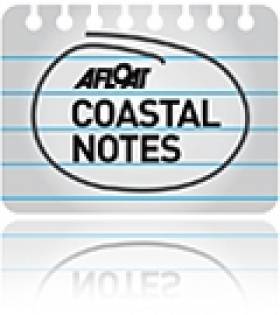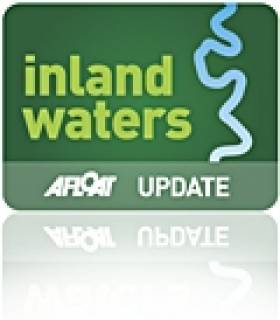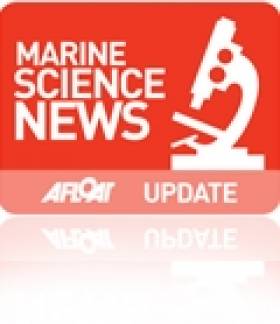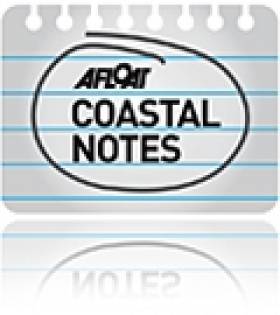Displaying items by tag: pollution
94% Of Irish Beaches Meet Stricter Bathing Quality Standards
#CoastalNotes - Ireland gets an 'A' for seaside bathing, as 94% of beaches have met the EU's new stricter water quality standards.
And as RTÉ News reports, three out of every four Irish beaches have been rated as 'excellent' on the new scale for levels of microbiological contaminants, which is "twice as strict" as in previous years.
But seven out of 136 bathing places monitored by the Environmental Protection Agency (EPA) in 2014 still failed the test.
Youghal in Cork, Clifden and Ballyloughane in Galway, Rush's south beach in North Co Dublin, Duncannon in Wexford, Ardmore in Waterford and Liliput on Lough Ennell in the Midlands were all rated 'poor', for the most part due to wastewater discharges.
Ten other popular seaside spots – including Trá na mBan in Spiddal and the beaches at Merrion Strand, Loughshinny and Balbriggan's front strand in Co Dublin - were rated as 'sufficient' as they are still prone to periodic pollution episodes, according to The Irish Times.
But there was good news for the denizens of Trá Inis Oirr in Galway Bay, which scored an 'excellent' rating in its first year on the EPA's list.
The Aran Islands beach was added in the same year that nearby Trá gCaorach became a first-time winner in the National Green Coast Awards.
The EPA's Splash website maps out the latest bathing quality ratings for beaches around and throughout Ireland. The agency's report on bathing quality in 2014 can be found HERE.
Coastal News: Connemara 'Disappearing', Landfill Erodes Into Irish Sea, Plastic Pollutes Oceans
#CoastalNotes - Is Connemara at risk of disappearing into the sea? According to one geologist, that's a distinct possibility.
As the Irish Mirror reports, Jonathon Wilkins noticed that the tide was flooding channels in a peat bog near NUI Galway – a tell-tale sign of 'post-glacial rebound'.
That's the process of the land recovering from the weight of glaciers during the Ice Age, and in most cases it means the level of the earth is rising, such as northern parts of the island of Ireland.
But Connemara is one of those that's dropping, and slowing slipping below sea level as the seawater effectively dissolves the bogs and granite bedrock.
Wales-based geological expert Wilkins described what he saw as "very powerful evidence that sea level, to my surprise, is rising in this area, and demonstrably over quite a short time scale."
Disappearing even faster into the sea is an old landfill site in Bray – and it's raised the ire of environmentalists.
According to the Belfast Telegraph, the disused rubbish tip north of the Co Wicklow seaside town continues to lose some of its 200,000 tonnes of refuse into the Irish Sea due to coastal erosion.
And that's despite the problem being identified more than 20 years ago, according to Coastwatch – which says some 200 metres of the face of the landfill site has been exposed by weathering, littering the cliffs below.
The pollution only adds to the 8.8 millions tonnes of plastic that's dumped into the world's oceans every year, according to the journal Science.
The Irish Times reports on these latest findings, which show that one third of this plastic waste is produced by China alone.
Rio Turns To Tech To Fight Water Pollution Problem
#Rio2016 - Rio is turning to Dutch researchers for help in combating its water pollution problems that continue to cause concern for the Olympic sailing fleet.
As the Associated Press reports, water research foundation Deltares has developed technology using data collected from both weather and water conditions to predict areas where litter accumulates, allowing Rio authorities to focus their clean-up efforts more efficiently.
It comes some days after a programme to retrieve floating rubbish from the sailing venue in Guanabara Bay was halted by city officials, reviving fears that Rio's 'dirty water problem' will not be solved in time for the 2016 Games.
Objects floating in the water have been cited as a major cause of concern by both Olympic and world sailing organisers, but water-borne contaminants have also been highlighted.
Last December news emerged of a newly discovered 'super-bacteria' that could pose a significant threat to health at next year's Summer Olympics for competitors like Annalise Murphy, James Espey, Ryan Seaton and Matt McGovern who have already nabbed their spots and will be training in Rio's "absolutely disgusting" waters ahead of the Olympics.
The Associated Press has much more on the story HERE.
Pig Farmer Prosecuted Over Lake Pollution 'Disgrace'
#InlandWaters - "An absolute disgrace" is how a judge branded a Longford farmer convicted of polluting a local lake near Lough Ree with slurry from his pig farm.
According to The Irish Times, Donal Connaughton of Newtowncashel was found to have caused or permitted effluent to fall from up to 25 slurry tanks containing a total of four million gallons from his property in March last year.
Longford District Court heard that many of the tanks were unauthorised structures and that Connaughton had removed their roofs to comply with a previous demolition order, only making the pollution problem worse by allowing overflow to enter local water courses.
Judge Séamus Hughes jailed Connaughton for 10 weeks and fined him €3,000 with €5,400 costs. The Irish Times has more on the story HERE.
'Super-Bacteria' Concern For Rio 2016 Sailing Waters
#Rio2016 - A newly discovered 'super-bacteria' could pose a serious threat to the health of sailors competing at the next Summer Olympics in Rio.
According to Reuters, scientists in the Brazilian city have found a strain of bacteria that can cause any number of internal infections – but is resistant to antibiotics.
The bacteria was discovered in samples taken from a river that feeds into the main sailing grounds for Rio 2016 at Guanabara Bay.
The latest news will be of grave concern to sailors like Annalise Murphy, James Espey, Ryan Seaton and Matt McGovern who are already headed to Rio and will frequent the city for competitions and training camps over the next 18 months leading up to the games.
It also comes after the disappointing news earlier this year that pollution issues in Rio's waters will not be solved in time for the Olympiad - a year after Irish Olympic coach Ian Barker described the city's waters as "absolutely disgusting".
Irish Coastal Water Quality 'Generally Good' Says Final Report On Biological Effects & Chemical Measurements
#MarineScience - The final report for Biological Effects and Chemical Measurements in Irish Marine Waters has just been published after four years of collaborative research led by Trinity College Dublin in partnership with the Marine Institute, Shannon Aquatic Toxicity Laboratory (Enterprise Ireland) and Dublin Institute of Technology.
The marine environment is affected by a complex mixture of man-made and naturally-occurring substances derived from a variety of sources such as shipping, sewage or industrial discharges or through accidental or historic spills of hazardous substances.
“Current monitoring and assessment of the pollution status of the marine environment in Ireland is mainly reliant on chemical measurements of contaminants in sediments, water and in 'bio-indicator' species," said Prof Jim Wilson of TCD.
"The success of this pilot project is that it reports the first major Irish study that examined both pollutant levels in the coastal environment while concurrently assessing the potential for biological-based effects on organisms exposed to these often hazardous substances."
Drawing on diverse expertise provided by a number of Government and academic research institutions, the study completed testing of a variety of chemical and biological-based monitoring tools in diverse coastal locations in Dublin, Wexford, Cork, Kerry, Clare and Galway.
The project confirmed that Irish coastal water quality is generally good, with the most elevated pollutant levels detected typically at more populated locations subject to greater impacts and pressures.
Lower pollutant levels were generally evident in less populated areas where diffuse pollution rather than local sources are of greater relevance.
In isolation, chemical measurement studies do not always explain the potential of the pressures that affect the ecosystem as a whole. The findings of this report note that using a suite of biological effects as part of an integrated approach to support chemical measurements gives a better overview of the health of our marine ecosystem.
For example, chemical compounds and mixtures present in the environment in combination with natural changes in the ocean, such as salinity or temperature, can all work in synergy or against each other to elicit diverse effects on the marine environment and on resident marine species.
“Individual pollutants or a mix of chemicals can cause metabolic disorders, increases in diseases becoming more common, as well as having an adverse effect on population growth and on species reproduction potential," said Dr Michelle Giltrap of TCD.
"An example of this is the reproductive effects on dog whelks, which were affected by the legacy of exposure to the biocide Tributyltin (TBT). TBT was widely used as an effective antifoulant on the hulls of ships and boats to prevent growth of aquatic organisms. Although use of TBT has been phased out internationally, the effects are still evident, but have been diminishing over time."
Dr Brian Donlon, who manages the Environmental Protection Agency's Research Programme, said “ongoing international commitments under the Marine Strategy Framework Directive require that member states monitor pollution in their marine waters by assessing both the level of chemical contamination and the effects of this contamination on organisms.
"Continued research and monitoring is required in order to further develop the dedicated chemical measurement and ecotoxicological response datasets.”
Dr Brendan McHugh of the Marine Institute added: “Integrated biological effects and chemical monitoring, including use of the novel tools, offer the potential for a more ecologically oriented approach to pollution monitoring and for further enhancing and supporting management actions in maintaining a sustainable marine environment."
The full report is available HERE on the Marine Institute’s Open Access Repository. The research project and was carried out under the Sea Change Strategy and the Marine Sub-Programme of the National Development Plan 2007-2013, and was jointly funded by the EPA and the Marine Institute.
#Rio - Rio de Janeiro's dirty water problem will not be solved by the time the Brazilian city hosts the next summer Olympic Games in 2016, as The New York Times reports.
Despite promises by city officials as far back as 2009 that Guanabara Bay and Rio's waterways would be cleaned of sewage and refuse by at least 80%, a recent letter obtained by the Associated Press news agency claims that at the current funding rate it would take a decade to reduce pollution to acceptable levels.
The letter from the office of Rio's state environment secretary to Sports Minister Aldo Rebelo is backed up by an AP analysis of national statistics which shows pollution in the city's waters is far above Brazil's national limits, which are themselves regarded as less stringent when compared to European standards.
As reported last December on Afloat.ie, Irish Olympic sailing coach branded the future Olympic waters of Rio as "absolutely disgusting", comparing Guanabara Bay to a "sewer" where training sailors had to repeatedly stop to disentangle refuse from their rudders.
State authorities are now asking for $70 million to build new river water treatment units to filter out waste before it reaches the bay, though it's expected to reduce current pollution levels by just 50% in time for the first sailing events.
The New York Times has more on the story HERE.
97% Of Ireland's Bathing Spots Rated Fit For A Dip
#CoastalNotes - The vast majority of Irish beaches are fit for bathing, according to the latest figures from the Environmental Protection Agency (EPA).
But as The Irish Times reports, any bathing spots that fail to meet the EU's minimum requirements in future will be closed for an entire season.
Of the 135 bathing places assessed by the EPA over the past 12 months, just four were rated as 'poor' quality.
Two of these were in Co Galway - Ballyloughane in Galway city, which experienced two pollution incidents; and Clifden, which "continues to be subject to episodic pollution" after it was identified among 40 towns nationwide still discharging raw sewage, though work is ongoing to upgrade the local treatment plant.
Some 114 bathing spots were rated 'good', and would have been rated higher if not for low but persistent bacterial levels in some East Coast waters.
Nationwide, the EPA's verdict is that better wastewater management practices have resulted in improving standards, maintaining Ireland's position as "one of the best countries in northern Europe" for water quality.
The Irish Times has much more on the story HERE.
Rising Seas Pose Future Leak Threat To Sellafield Dump
#IrishSea - One million cubic metres of radioactive waste at a dump site near Sellafield is at risk of contaminating the Irish Sea in the future, according to papers released by Britain's Environment Agency.
According to The Guardian, the internal report says it is "doubtful" whether the location of the Drigg Low-Level Waste Repository (LLWR) on the Cumbrian coast "would be chosen for a new facility for near-surface radioactive waste disposal if the choice were being made now."
Though the full effects of coastal erosion, weathering and flooding are not expected to be felt until "a few hundred to a few thousand years from now", the agency has expressed worry over the site's gradual exposure to the elements.
This is compounded by fears that past deposits at the site over the last 55 years have included higher-level radioactive waste than intended.
The Guardian has more on the story HERE.
Decision Due Next Month On Future Of Cork Harbour Toxic Dump
#CorkHarbour - 24 April is the date set for a decision on the clean-up of the toxic waste site on Haulbowline Island in Cork Harbour, as RTÉ News reports.
The news comes at the conclusion of the oral hearing into proposals for the former Irish Steel/Ispat plant, for which the only submission received was from the applicant Cork City Council.
The hearing was told by risk consultants representing the council that the site in its present state no immediate or long-term risk to the community at large.
However, Dr Cecilia MacLeod of consultants WYG echoed the concerns of local councillors last month over breaches in the embankments around the toxic dump, which contains some half a million tonnes of waste, when she said the site remains a health risk to the locality.
Plans for the site currently involve landscaping the area, with a perimeter wall to prevent leaching of potentially hazardous or carcinogenic matter.
RTÉ News has more on the story HERE.







































































